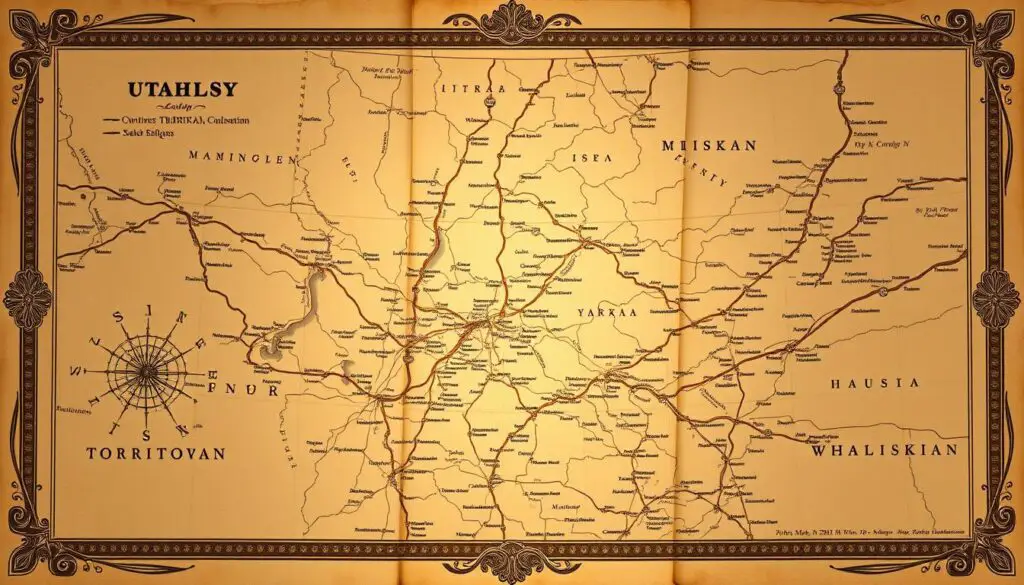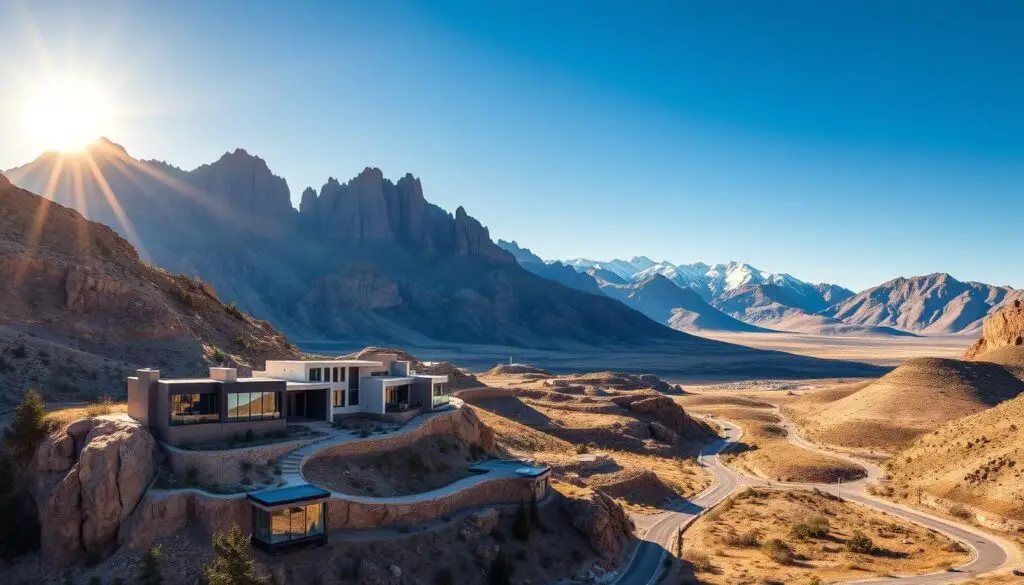Welcome to Utah, a region shaped by faith, resilience, and stunning landscapes. Often called the “Mormon State”, its identity is deeply tied to pioneers who journeyed westward seeking religious freedom. Their story begins in the 1840s, when members of the Church left New York and crossed rugged terrain to build a new home near the Great Salt Lake.
This bold migration transformed the area into a thriving territory. Early settlers faced harsh climates and scarce resources, yet their determination laid the foundation for Utah’s unique culture. The Great Salt Lake became more than a landmark—it symbolized hope and survival for those forging a community in the American West.
Their efforts created a distinct blend of faith and frontier spirit. Over time, these pioneers established systems of governance that reflected their values, setting the stage for Utah’s eventual statehood. Today, traces of their legacy are visible in historic sites, traditions, and the tight-knit communities across the region.
Join us as we explore how this journey from New York to the Salt Lake Valley shaped a state unlike any other in the United States. From its humble beginnings to its enduring heritage, Utah’s past offers a fascinating window into perseverance and identity.
Key Takeaways
- Utah’s cultural roots trace back to pioneers seeking religious freedom in the 19th century.
- The Great Salt Lake served as a vital symbol of survival for early settlers.
- Challenges like harsh weather tested the resilience of founding communities.
- Unique systems of self-governance emerged during the territory’s early years.
- Historic sites across the state preserve this transformative era in American history.
Historical Roots and Formation of a Religious Community
In the heart of the Great Basin, a determined group laid the foundation for a new community. Members of the Church of Jesus Christ embarked on a grueling journey westward during the 1840s. Their goal? To create a self-governing society rooted in shared beliefs.
From Deseret to Utah Territory
Originally calling their proposed homeland Deseret, these pioneers envisioned a vast territory stretching from Colorado to California. However, the United States government had other plans. By 1850, the area was renamed the Utah Territory—a compromise reflecting political tensions of the era.
Brigham Young’s Vision and Leadership
Guiding this effort was Brigham Young, whose practical wisdom shaped every aspect of settlement. He organized irrigation systems using the Great Salt Lake’s resources and established towns with communal support networks. Challenges like droughts and isolation tested their resolve, but faith fueled their perseverance.
Key elements of their success:
- Cooperative farming practices in arid lands
- Strategic use of mountain streams for agriculture
- Interconnected settlements for mutual aid
This blend of spiritual unity and frontier ingenuity created lasting patterns still visible in Utah’s towns and traditions today.
The Political Evolution of Utah’s Territory
As pioneers settled near the Great Salt Lake, political ambitions emerged alongside survival efforts. Leaders sought recognition from the United States while preserving their vision of self-rule—a delicate balance that defined Utah’s early governance.

The Proposal for the State of Deseret
In 1849, elected delegates drafted a constitution for the “State of Deseret.” This provisional government aimed to cover modern-day Utah, Nevada, and parts of six neighboring states. Their swift action reflected a desire for political independence.
The proposal faced immediate challenges. Congress hesitated to approve a region governed by religious principles. Meanwhile, boundary disputes with neighboring territories created friction.
Congressional Compromises and Territorial Status
By 1850, the U.S. government reshaped Deseret into the smaller Utah Territory. Federal leaders worried about concentrated regional power. They appointed territorial governors while allowing limited local elections.
Key compromises included:
- Redrawing borders to exclude gold-rich California areas
- Requiring federal approval for major laws
- Maintaining military oversight of trade routes
| Deseret Proposal | Utah Territory | Outcome |
|---|---|---|
| 220,000 sq miles | 87,000 sq miles | Reduced autonomy |
| Religious governance | Federal oversight | Political tension |
| Elected judges | Appointed officials | Shift in legal authority |
These changes sparked conflict but ultimately integrated Utah into national systems. The territory’s evolving structure laid groundwork for future statehood debates.
The Enduring Impact of the mormon state on Utah
Utah’s identity is a tapestry woven with threads of faith and perseverance, reflecting the enduring legacy of its founders. From community values to public art, the region’s heritage remains alive in everyday life. Let’s explore how this influence shapes modern culture and symbolism.
Cultural Heritage and Religious Influence
Traditions rooted in early pioneer life still thrive here. Many towns host festivals celebrating unity and hard work—values central to the original settlers. The teachings of Christ’s latter-day followers continue to inspire charitable efforts and family-focused initiatives.
Landmarks like the Great Salt Lake serve as more than natural wonders. They’re woven into local stories as symbols of endurance. Early leadership emphasized education, leading to institutions that blend faith with learning.
Legacy in Symbols and State Identity
Look closely, and you’ll spot the beehive everywhere—on flags, buildings, and even highway signs. This icon represents teamwork, a core principle for those who transformed the arid range into fertile land. The Salt Lake Valley’s skyline, dotted with steeples, echoes this blend of past and present.
From the Great Salt Lake’s shimmering shores to pioneer-era architecture, Utah’s landscape tells a story of resilience. These symbols aren’t just history—they’re reminders of a community built on shared purpose.
Modern Developments and Integration into the United States
The 20th century ushered in transformative changes for Utah’s governance and society. As the region balanced its unique heritage with national expectations, shifts in policy and values reshaped its identity. Central to this evolution was the move away from religious-led systems toward structures aligned with the broader United States framework.

From Isolation to Inclusion
A pivotal moment came in 1890, when leaders formally ended the practice of polygamy. This decision eased tensions with the federal government and opened doors for statehood. Six years later, Utah joined the United States as its 45th member—a milestone marking its political integration.
Key developments accelerated this transition:
- Adoption of secular public education systems
- Expansion of railroads through the Rocky Mountains
- Gradual transfer of local authority to elected officials
Though cultural traditions remained strong, new laws reflected national priorities. The government shifted from faith-based leadership to representative democracy, addressing issues like land rights and economic growth.
| Year | Event | Impact |
|---|---|---|
| 1890 | Polygamy renounced | Reduced federal conflict |
| 1896 | Statehood achieved | Full inclusion in U.S. systems |
| 1910s | Railroad expansion | Connected Utah to national markets |
Geographic barriers like the Rocky Mountains once isolated communities. Over time, these same peaks became gateways for tourism and industry. Today, Utah’s blend of pioneering spirit and modern innovation showcases how tradition and progress can coexist.
Conclusion
Utah’s story is one of transformation—from a visionary religious settlement to a fully integrated part of the United States. Over 150 years, pioneers transformed the harsh territory into thriving communities through shared purpose. Early members of the Church of Jesus Christ laid foundations that still shape local values today.
The shift from Deseret’s self-rule to federal governance marked a turning point. Delegates worked tirelessly to balance tradition with national expectations. By 1896, their efforts secured statehood, blending frontier resilience with modern systems.
Leaders like Brigham Young and early elected officials navigated droughts, politics, and cultural shifts. Their legacy lives in Utah’s towns, symbols like the beehive, and cooperative spirit. Even now, the government reflects this mix of innovation and heritage.
From arid valleys to bustling cities, Utah’s journey reminds us how vision and perseverance build lasting communities. Explore its trails, museums, and traditions to witness this living history firsthand.
FAQ
Why was Utah originally called the "State of Deseret"?
Early settlers led by Brigham Young proposed the name “Deseret,” a term from The Book of Mormon meaning “honeybee.” It symbolized industry and cooperation. However, the U.S. Congress rejected this name in 1850, designating it the Utah Territory instead.
How did Brigham Young shape Utah’s development?
As the second president of The Church of Jesus Christ of Latter-day Saints, Brigham Young directed the settlement of the Great Basin. His leadership established irrigation systems, towns, and a self-sufficient economy, laying Utah’s foundational infrastructure and culture.
What delayed Utah’s path to U.S. statehood?
Conflicts over polygamy and theocratic governance caused tension with the federal government. Utah became a state in 1896—45 years after initial proposals—after The Church of Jesus Christ of Latter-day Saints officially ended plural marriage and separated religious and political authority.
How does the legacy of early settlers influence Utah today?
Pioneers’ values like community-building and resilience remain central. Symbols like the beehive and sego lily reflect this heritage, while cities such as Salt Lake City and Provo showcase historic architecture tied to the region’s religious roots.
What role did the Rocky Mountains play in Utah’s history?
The rugged terrain provided isolation for settlers seeking religious freedom. It also posed challenges for agriculture, leading to innovations like communal water management that shaped Utah’s unique approach to resource-sharing.
How did Utah transition from a theodemocracy to a modern state?
After decades of federal pressure, leaders shifted toward secular governance. This included adopting public education, diversifying the economy beyond agriculture, and aligning laws with national standards, ensuring Utah’s integration into the broader United States.